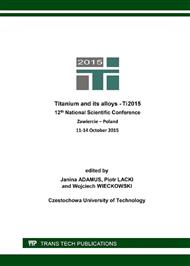[1]
Titanium and Titanium Alloys. Welding handbook. Vol. 4, Materials and Applications, part 2. American welding Society, Miami (1998).
Google Scholar
[2]
G. Winiarski, A. Gontarz, Z. Pater, A new process for the forming of a triangular flange in hollow shafts from Ti6Al4V alloy. Arch. Civ. Mech. Eng. 15 (2015) 911-916.
DOI: 10.1016/j.acme.2015.01.001
Google Scholar
[3]
P. Kettner, F. Schmieder, Manufacturing of hollow transmission shaft via bulk – metal forging. J. Mater. Process. Tech. 71 (1997) 113-118.
DOI: 10.1016/s0924-0136(97)00156-8
Google Scholar
[4]
S. Urankar, M. Lovell, C. Morrow, K. Kawada, Establishment of failure conditions for the cross-wedge rolling of hollow shafts, J. Mater. Process. Tech. 177 (2006) 545-549.
DOI: 10.1016/j.jmatprotec.2006.04.052
Google Scholar
[5]
C.C. Wong, J. Lin, T.A. Dean, Effects of roller path and geometry on the flow forming of solid cylindrical components, J. Mater. Process. Tech. 167 (2005) 344-353.
DOI: 10.1016/j.jmatprotec.2005.05.039
Google Scholar
[6]
Z. Pater, A. Tofil, Experimental and theoretical analysis of the cross – wedge rolling process in cold forming conditions, Arch Metall Mater. 52 (2007) 289-297.
Google Scholar
[7]
Z. Pater, Cross Wedge Rolling, Lublin University of Technology, 2009 (in Polish).
Google Scholar
[8]
Z. Pater, J. Tomczak, J. Bartnicki, M. R. Lovell, P. L. Menezes, Experimental and numerical analysis of helical – wedge rolling process for producing steel balls, Int. J. Mach. Tool Manu. 67 (2013) 1-7.
DOI: 10.1016/j.ijmachtools.2012.12.006
Google Scholar
[9]
A. Tofil, Research of new splitting process of pipe billets from 2618A aluminium alloy basing on cross-wedge rolling, Arch. Metall. Mater. 58 (2013) 725-729.
DOI: 10.2478/amm-2013-0061
Google Scholar
[10]
Z. Pater, J. Tomczak, Method for plastic forming of toothed shafts. European patent no. EP 2422898, (2013).
Google Scholar
[11]
Z. Pater, J. Tomczak, Rotary Compression of Hollow Parts by Cross Rolling. European patent no. EP 2422896, (2013).
Google Scholar
[12]
Simufact. material 2012. 0. 0. 14871, Simufact engineering gmbh, Hamburg.
Google Scholar
[13]
H. N. Hana, K. H. Kim, A ductile fracture criterion in sheet metal forming process, J. Mater. Process. Tech. 142 (2003) 231–238.
DOI: 10.1016/s0924-0136(03)00587-9
Google Scholar


